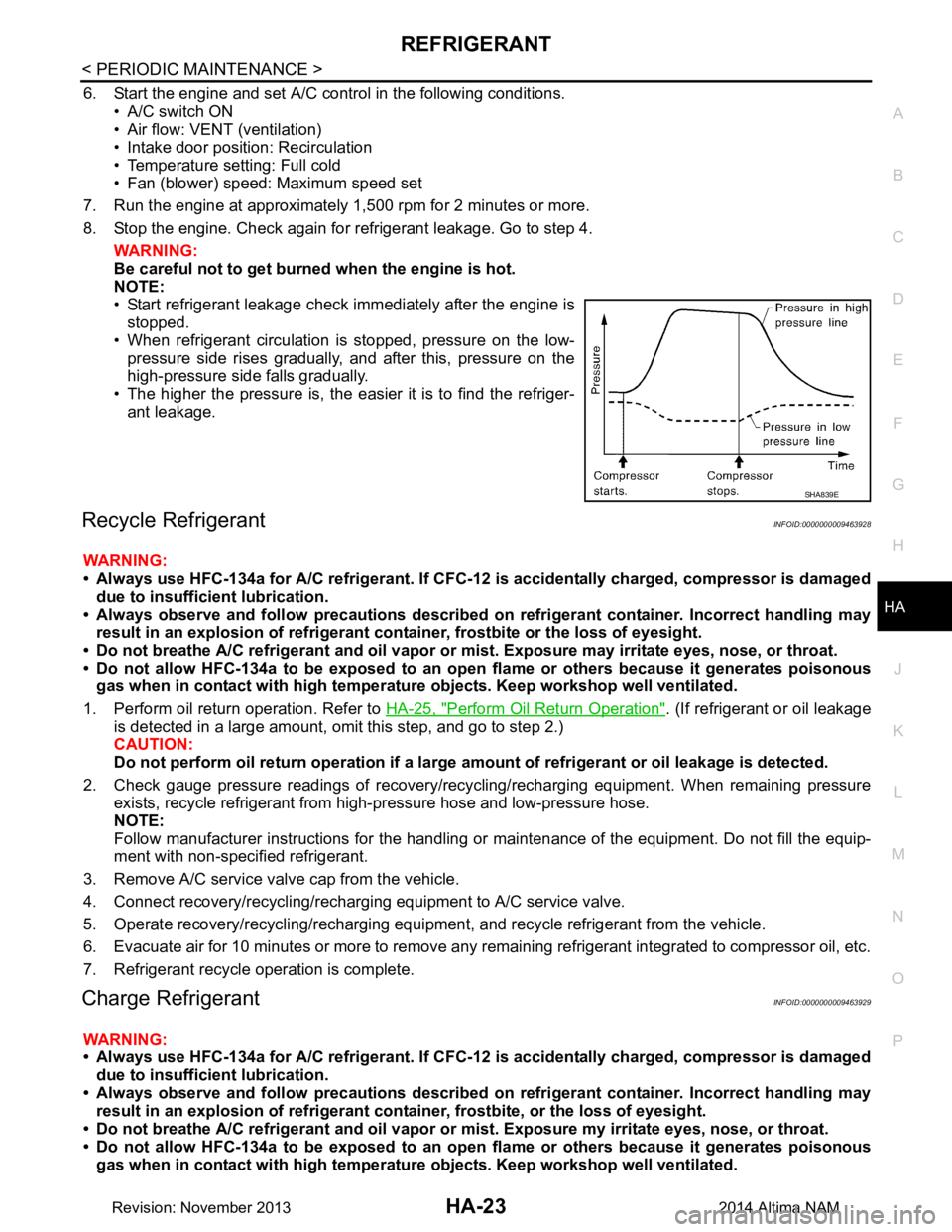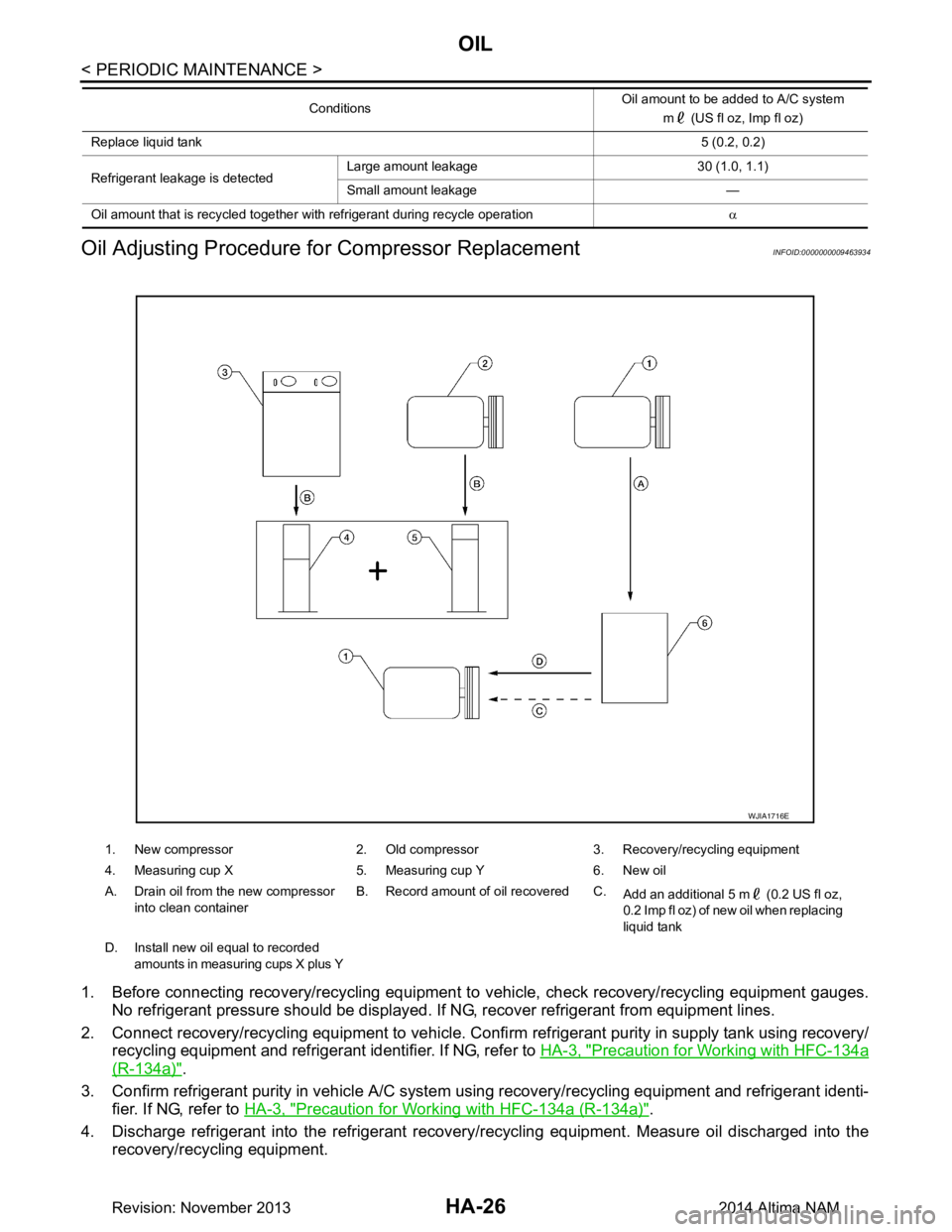2014 NISSAN TEANA Pro pressure
[x] Cancel search: Pro pressurePage 2628 of 4801

HA-22
< PERIODIC MAINTENANCE >
REFRIGERANT
4. Press UV lamp switch (5) and check A/C system for refrigerant leakage. (Where refrigerant leakage
occurs, fluorescent leak detec tion dye appears in green color.)
WARNING:
Do not look directly into UV lamp light source.
NOTE:
• For continuous operating time of UV lamp, follow the manufacturer operating instructions.
• Illuminate piping joints from different angles using UV lamp and check that there is no leakage.
• Use a mirror in area that is difficult to see to check refrigerant leakage.
• Refrigerant leakage from evaporator can be detected by soaking cotton swab or a similar material with
drain hose water and illuminating it using UV lamp.
• Dust, dirt and packing materials adhesive used for condenser, evaporator, and other locations may fluo- resce. Be careful not to misidentify leakage.
5. Repair or replace parts where refrigerant leakage occurs and wipe off fluorescent leak detection dye. NOTE:
Completely wipe off fluorescent leak detection dy e from gaps between parts, screw threads, and others
using a cotton swab or similar materials.
6. Use a UV lamp to check that no fluorescent leak detection dye remains after finishing work.
WARNING:
Do not look directly into UV lamp light source.
NOTE:
• For continuous operating time of UV lamp, follow the manufacturer operating instructions.
• Dust, dirt, and packing materials adhesive used for condenser, evaporator, and other locations may flu-
oresce. Be careful not to misidentify leakage.
CHECK REFRIGERANT LEAKAGE USING ELECTRICAL LEAK DETECTOR
WARNING:
Do not check refrigerant leakage while the engine is running.
CAUTION:
Be careful of the following it ems so that inaccurate checks or misidentifications are avoided.
• Do not allow refrigerant vapor, shop chemical vapor s, cigarette smoke or others around the vehicle.
• Always check refrigerant leakage in a low air flow en vironment so that refrigerant may not disperse
when leakage occurs.
1. Stop the engine.
2. Connect recovery/recycling/recharging equipment or manifold gauge set (J-39183-C) to A/C service
valve.
3. Check that A/C refrigerant pressure is 345 kPa (3.52 kg/cm
2, 50 psi) or more when temperature is 16 °C
(61 °F) or more. When pressure is lower than the specif ied value, recycle refrigerant completely and fill
refrigerant to the specified level.
NOTE:
Leakages may not be detected if A/C refrigerant pressure is 345 kPa (3.52 kg/cm
2, 50 psi) or less when
temperature is less than 16 °C (61 °F).
4. Clean area where refrigerant leakage check is performed and check refrigerant leakage along all surfaces of pipe connections and A/C system components us ing electrical leak detector (J-41995) probe.
CAUTION:
• Continue checking when a leakag e is found. Always continue and complete checking along all
pipe connections and A/C system components for additional leakage.
• When a leakage is detected, clean leakage area using compressed air and check again.
• When checking leakage of cooling unit inside, always clean inside of drain hose so that the
probe surface may not be exposed to water or dirt.
NOTE:
• Always check leakage starting from high-pressure side and continue to low-pressure side.
• When checking leakage of cooling unit inside, operate bl ower fan motor for 15 minutes or more at the
maximum fan speed while the engine is stopped, and then in sert electrical leak detector probe into drain
hose and hold for 10 minutes or more.
• When disconnecting shut-off valve that is connected to A/C service valve, always evacuate remaining
refrigerant so that misidentification can be avoided.
5. Repair or replace parts where refrigerant leak age is detected. (Leakage is detected but leakage area is
unknown.)
Revision: November 20132014 Altima NAM
Page 2629 of 4801

REFRIGERANTHA-23
< PERIODIC MAINTENANCE >
C
D E
F
G H
J
K L
M A
B
HA
N
O P
6. Start the engine and set A/C control in the following conditions. • A/C switch ON
• Air flow: VENT (ventilation)
• Intake door position: Recirculation
• Temperature setting: Full cold
• Fan (blower) speed: Maximum speed set
7. Run the engine at approximately 1,500 rpm for 2 minutes or more.
8. Stop the engine. Check again for refrigerant leakage. Go to step 4. WARNING:
Be careful not to get burned when the engine is hot.
NOTE:
• Start refrigerant leakage check immediately after the engine is stopped.
• When refrigerant circulation is stopped, pressure on the low- pressure side rises gradually, and after this, pressure on the
high-pressure side falls gradually.
• The higher the pressure is, the easier it is to find the refriger-
ant leakage.
Recycle RefrigerantINFOID:0000000009463928
WARNING:
• Always use HFC-134a for A/C refrigerant. If CFC-12 is accidentally charged, compressor is damaged
due to insufficient lubrication.
• Always observe and follow precaution s described on refrigerant container. Incorrect handling may
result in an explosion of refrigerant co ntainer, frostbite or the loss of eyesight.
• Do not breathe A/C refrigerant and oil vapor or mi st. Exposure may irritate eyes, nose, or throat.
• Do not allow HFC-134a to be exposed to an open flame or others because it generates poisonous
gas when in contact with high temperatur e objects. Keep workshop well ventilated.
1. Perform oil return operation. Refer to HA-25, "Perform Oil Return Operation"
. (If refrigerant or oil leakage
is detected in a large amount, omit this step, and go to step 2.)
CAUTION:
Do not perform oil return operation if a large am ount of refrigerant or oil leakage is detected.
2. Check gauge pressure readings of recovery/recyc ling/recharging equipment. When remaining pressure
exists, recycle refrigerant from high-pressure hose and low-pressure hose.
NOTE:
Follow manufacturer instructions for the handling or maintenance of the equipment. Do not fill the equip-
ment with non-specified refrigerant.
3. Remove A/C service valve cap from the vehicle.
4. Connect recovery/recycling/recharging equipment to A/C service valve.
5. Operate recovery/recycling/recharging equipment , and recycle refrigerant from the vehicle.
6. Evacuate air for 10 minutes or more to remove any remaining refrigerant integrated to compressor oil, etc.
7. Refrigerant recycle operation is complete.
Charge RefrigerantINFOID:0000000009463929
WARNING:
• Always use HFC-134a for A/C refrigerant. If CFC-12 is accidentally charged, compressor is damaged
due to insufficient lubrication.
• Always observe and follow precaution s described on refrigerant container. Incorrect handling may
result in an explosion of refrigerant co ntainer, frostbite, or the loss of eyesight.
• Do not breathe A/C refrigerant and oil vapor or mi st. Exposure my irritate eyes, nose, or throat.
• Do not allow HFC-134a to be exposed to an open flame or others because it generates poisonous
gas when in contact with high temperatur e objects. Keep workshop well ventilated.
SHA839E
Revision: November 20132014 Altima NAM
Page 2630 of 4801

HA-24
< PERIODIC MAINTENANCE >
REFRIGERANT
1. Connect recovery/recycling/recharging equipment to the A/C service valve.
2. Operate recovery/recycling/recharging equipment, and evacuate air from A/C system for 25 minutes or
more.
CAUTION:
Evacuate air for 15 minutes or more if the parts are replaced.
3. Check the airtightness of A/C system for 25 minutes or more. If pressure raises more than the specified
level, charge A/C system with approximately 200g refriger ant and check that there is no refrigerant leak-
age. Refer to HA-21, "Leak Test"
.
CAUTION:
Check the airtightness for 15 minutes or more if the parts are replaced.
4. If parts other than compressor are replaced, fill co mpressor oil according to parts that are replaced.
5. Charge the specified amount of refrigerant to A/C system.
6. Check that A/C system operates normally.
7. Disconnect recovery/recycling/recharging equipment. (Col lect the refrigerant from the high-pressure hose
and low-pressure hose of recovery/recycling/recharging equipment.)
8. Install A/C service valve cap.
9. Refrigerant charge is complete.
Revision: November 20132014 Altima NAM
Page 2632 of 4801

HA-26
< PERIODIC MAINTENANCE >
OIL
Oil Adjusting Procedure fo r Compressor Replacement
INFOID:0000000009463934
1. Before connecting recovery/recycling equipment to vehicle, check recovery/recycling equipment gauges.
No refrigerant pressure should be displayed. If NG, recover refrigerant from equipment lines.
2. Connect recovery/recycling equipment to vehicle. Confi rm refrigerant purity in supply tank using recovery/
recycling equipment and refrigerant identifier. If NG, refer to HA-3, "Precaution for Working with HFC-134a
(R-134a)".
3. Confirm refrigerant purity in vehi cle A/C system using recovery/recycling equipment and refrigerant identi-
fier. If NG, refer to HA-3, "Precaution for Working with HFC-134a (R-134a)"
.
4. Discharge refrigerant into the refrigerant recove ry/recycling equipment. Measure oil discharged into the
recovery/recycling equipment.
Replace liquid tank 5 (0.2, 0.2)
Refrigerant leakage is detected Large amount leakage 30 (1.0, 1.1)
Small amount leakage —
Oil amount that is recycled together with refrigerant during recycle operation α
Conditions
Oil amount to be added to A/C system
m (US fl oz, Imp fl oz)
1. New compressor 2. Old compressor 3. Recovery/recycling equipment
4. Measuring cup X 5. Measuring cup Y 6. New oil
A. Drain oil from the new compressor into clean container B. Record amount of oil recovered C.
Add an additional 5 m (0.2 US fl oz,
0.2 Imp fl oz) of new oil when replacing
liquid tank
D. Install new oil equal to recorded amounts in measuring cups X plus Y
WJIA1716E
Revision: November 20132014 Altima NAM
Page 2634 of 4801

HA-28
< PERIODIC MAINTENANCE >
PERFORMANCE TEST
PERFORMANCE TEST
InspectionINFOID:0000000009463935
INSPECTION PROCEDURE
1. Connect recovery/recycling/recharging equipment (for HFC-134a) or manifold gauge.
2. Start the engine, and set to the following condition.
Test condition
3. Maintain test condition until A/C system becomes stable. (Approximately 10 minutes)
4. Check that test results of “recirculating-to-disc harge air temperature” and “ambient air temperature-to-
operating pressure” are within the specified value.
5. When test results are within the spec ified value, inspection is complete.
If any of test result is out of the specifi ed value, perform diagnosis by gauge pressure. Refer to HA-17,
"Symptom Table".
RECIRCULATING-TO-DISCHARGE AIR TEMPERATURE TABLE
AMBIENT AIR TEMPERATURE-TO-OPERATING PRESSURE TABLE
Surrounding condition Indoors or in the shade (in a well-ventilated place)
Vehicle condition Door Closed
Door glass Full open
Hood Open
Engine speed Idle speed
A/C condition Temperature control switch or dial Full cold
A/C switch ON
Air outlet VENT (ventilation)
Intake door position Recirculation
Fan (blower) speed Maximum speed set
Inside air (Recirculating air) at blower assembly inlet Discharge air temperature from center ventilator
°C ( °F)
Relative humidity
% Air temperature
°C ( °F)
50 – 60 20 (68) 4.7 – 6.7 (40 – 44)
25 (77) 8.6 – 11.1 (47 – 52)
30 (86) 12.6 – 15.6 (55 – 60)
35 (95) 19.0 – 22.5 (66 – 73)
60 – 70 20 (68) 6.7 – 8.7 (44 – 48)
25 (77) 11.1 – 13.6 (52 – 56)
30 (86) 15.6 – 18.6 (60 – 65)
35 (95) 22.5 – 26.0 (73 – 79)
Revision: November 20132014 Altima NAM
Page 2652 of 4801

HAC-3
C
D E
F
G H
J
K L
M A
B
HAC
N
O P
AMBIENT SENSOR ....................................... ..103
Removal and Installation .......................................103
IN-VEHICLE SENSOR ................................... ..104
Removal and Installation .......................................104
SUNLOAD SENSOR ...................................... ..105
Removal and Installation .......................................105
INTAKE SENSOR .......................................... ..106
Removal and Installation .......................................106
REFRIGERANT PRESSURE SENSOR ......... ..107
Removal and Installation .......................................107
DOOR MOTOR ............................................... ..108
Exploded View .................................................... ..108
INTAKE DOOR MOTOR ........................................ ..109
INTAKE DOOR MOTOR : Removal and Installa-
tion ...................................................................... ..
109
MODE DOOR MOTOR .......................................... ..109
MODE DOOR MOTOR : Removal and Installation ..109
AIR MIX DOOR MOTOR ....................................... ..109
AIR MIX DOOR MOTOR : Removal and Installa-
tion - Air Mix Door Motor (RH) ............................. ..
109
AIR MIX DOOR MOTOR : Removal and Installa-
tion - Air Mix Door Motor (LH) ............................. ..
109
MANUAL AIR CONDITIONER
PRECAUTION ................ ............................
110
PRECAUTIONS .............................................. ..110
Precaution for Supplemental Restraint System
(SRS) "AIR BAG" and "SEAT BELT PRE-TEN-
SIONER" ............................................................. ..
110
Precaution for Work ..............................................110
Working with HFC-134a (R-134a) .........................110
Precaution for Service Equipment .........................111
PREPARATION .........................................113
PREPARATION .............................................. ..113
Special Service Tool ........................................... ..113
Commercial Service Tool ......................................113
SYSTEM DESCRIPTION ...........................114
COMPONENT PARTS ................................... ..114
Component Part Location ................................... ..114
Component Description .........................................115
SYSTEM ...........................................................117
System Diagram .................................................. ..117
System Description ...............................................117
Air Flow Control .....................................................118
Air Inlet Control .....................................................118
Air Outlet Control ...................................................118
Compressor Control ..............................................118
Door Control ..........................................................119
Temperature Control ........................................... ..121
OPERATION ...................................................122
Switch Name and Function ....................................122
DIAGNOSIS SYSTEM (BCM) .........................124
CONSULT Function (BCM - COMMON ITEM) ......124
CONSULT Function (BCM - AIR CONDITIONER) ..125
DIAGNOSIS SYSTEM (IPDM E/R) .................126
CONSULT Function (IPDM E/R) ...........................126
ECU DIAGNOSIS INFORMATION ............128
FRONT AIR CONTROL ..................................128
Reference Value .................................................. ..128
ECM, IPDM E/R, BCM .....................................129
List of ECU Reference ...........................................129
WIRING DIAGRAM ....................................130
AIR CONDITIONER CONTROL ......................130
Wiring Diagram .................................................... ..130
BASIC INSPECTION .................................139
DIAGNOSIS AND REPAIR WORKFLOW ......139
Work Flow ............................................................ ..139
OPERATION INSPECTION ............................140
Work Procedure .....................................................140
DTC/CIRCUIT DIAGNOSIS .......................142
MODE DOOR MOTOR ....................................142
Diagnosis Procedure ........................................... ..142
AIR MIX DOOR MOTOR .................................144
Diagnosis Procedure .............................................144
INTAKE DOOR MOTOR .................................146
Diagnosis Procedure .............................................146
BLOWER MOTOR ..........................................148
Diagnosis Procedure .............................................148
Component Inspection (Blower Motor) ..................149
Component Inspection (Front Blower Motor Re-
lay) ....................................................................... ..
149
MAGNET CLUTCH .........................................151
Component Function Check ..................................151
Diagnosis Procedure .............................................151
POWER SUPPLY AND GROUND CIRCUIT
FOR FRONT AIR CONTROL ..........................
152
Description ........................................................... ..152
Component Function Check ..................................152
Diagnosis Procedure .............................................152
SYMPTOM DIAGNOSIS ............................154
Revision: November 20132014 Altima NAMRevision: November 20132014 Altima NAM
Page 2653 of 4801

HAC-4
HEATER AND AIR CONDITIONING SYSTEM
CONTROL SYMPTOMS ................................. .
154
Symptom Table ................................................... ..154
INSUFFICIENT COOLING ...............................155
Component Function Check ................................ ..155
INSUFFICIENT HEATING ...............................157
Component Function Check ................................ ..157
COMPRESSOR DOES NOT OPERATE .........159
Description ........................................................... ..159
Diagnosis Procedure .............................................159
REMOVAL AND INSTALLATION ..............161
FRONT AIR CONTROL .................................. .161
Removal and Installation ..................................... ..161
IN-VEHICLE SENSOR ......................................162
Removal and Installation .......................................162
REFRIGERANT PRESSURE SENSOR ......... ..163
Removal and Installation .......................................163
DOOR MOTOR ............................................... ..164
Exploded View ..................................................... .164
INTAKE DOOR MOTOR ........................................ .165
INTAKE DOOR MOTOR : Removal and Installa-
tion ....................................................................... .
165
MODE DOOR MOTOR ........................................... .165
MODE DOOR MOTOR : Removal and Installation .165
AIR MIX DOOR MOTOR ........................................ .165
AIR MIX DOOR MOTOR : Removal and Installa-
tion ....................................................................... .
165
Revision: November 20132014 Altima NAMRevision: November 20132014 Altima NAM
Page 2665 of 4801
![NISSAN TEANA 2014 Service Manual
HAC-16
< SYSTEM DESCRIPTION >[AUTOMATIC AIR CONDITIONER]
SYSTEM
Air Outlet Control
INFOID:0000000009463097
• While air outlet is in automatic control, A/C auto amp. selects the mode door position d NISSAN TEANA 2014 Service Manual
HAC-16
< SYSTEM DESCRIPTION >[AUTOMATIC AIR CONDITIONER]
SYSTEM
Air Outlet Control
INFOID:0000000009463097
• While air outlet is in automatic control, A/C auto amp. selects the mode door position d](/manual-img/5/57390/w960_57390-2664.png)
HAC-16
< SYSTEM DESCRIPTION >[AUTOMATIC AIR CONDITIONER]
SYSTEM
Air Outlet Control
INFOID:0000000009463097
• While air outlet is in automatic control, A/C auto amp. selects the mode door position depending on a target air mix door angle and
outlet air temperature calculated from sunload.
• If ambient temperature is excessively low, D/F is selected to pre- vent windshield fogging when air outlet is set to FOOT.
Compressor ControlINFOID:0000000009463098
DESCRIPTION
• When the compressor activation condition is satisfied whil e blower motor is activated, A/C auto amp. trans-
mits A/C ON signal and blower fan ON signal to ECM via CAN communication.
• ECM judges that the compressor can be activated depending on the state of each sensor (refrigerant pres-
sure sensor signal and others) and transmits A/C comp ressor request signal to IPDM E/R via CAN commu-
nication.
• IPDM E/R turns A/C relay ON and activate s the compressor depending on request from ECM.
COMPRESSOR PROTECTION CONTROL AT PRESSURE MALFUNCTION
When high-pressure side value that is detected by refrigerant pressure sensor is as per the following state,
ECM requests IPDM E/R to turn A/C relay OFF and stops the compressor.
• 3.12 MPa (31.82 kg/cm
2, 452.4 psi) or more (When the engine speed is less than 1,500 rpm)
• 2.74 MPa (27.95 kg/cm
2, 397.3 psi) or more (When the engine speed is 1,500 rpm or more)
• 0.14 MPa (1.43 kg/cm
2, 20.3 psi) or less
COMPRESSOR OIL CIRCULATION CONTROL
When the engine starts while the engine coolant temperature is 56 °C (133 °F) or less, ECM activates the com-
pressor for approximately 6 seconds and circulates the compressor lubricant once.
LOW TEMPERATURE PROTECTION CONTROL
• When intake sensor detects that front evaporator fin temperature is 2.5 °C (37 °F) or less, A/C auto amp. requests ECM to turn com-
pressor OFF, and stops the compressor.
• When the front evaporator fin temperature returns to 5.0 °C (41 °F)
or more, the compressor is activated.
OPERATING RATE CONTROL
When set temperature is other than fully cold or air out let is “VENT”, “B/L” or “FOOT” A/C auto amp. controls
the compressor activation depending on ambient temperature.
AIR CONDITIONING CUT CONTROL
When set engine is running is excessively high load conditi on, ECM requests IPDM E/R to turn A/C relay OFF,
and stops the compressor. Refer to EC-56, "AIR CONDITIONING CUT CONT ROL : System Description (with
automatic air conditioner)" (QR25DE) or EC-573, "AIR CONDITIONING CUT CONTROL : System Descrip-
tion" (VQ35DE) for details.
JMIIA0730GB
JMIIA0742GB
Revision: November 20132014 Altima NAMRevision: November 20132014 Altima NAM